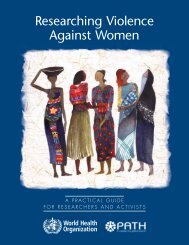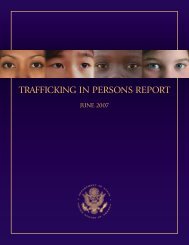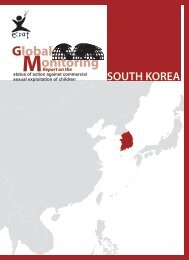Download PDF - Violence Against Children - East Asia and the ...
Download PDF - Violence Against Children - East Asia and the ...
Download PDF - Violence Against Children - East Asia and the ...
You also want an ePaper? Increase the reach of your titles
YUMPU automatically turns print PDFs into web optimized ePapers that Google loves.
Cambodia<br />
near <strong>the</strong> garbage dump have also benefited<br />
from <strong>the</strong> project’s advocacy to local<br />
authorities.<br />
In <strong>the</strong> 12 months until October 2002, 48<br />
children had been involved in a vocational<br />
training activity resulting in alternative<br />
livelihoods, 658 loans had been made to<br />
families for small businesses, 1,998 children<br />
were involved in non-formal education, <strong>and</strong><br />
962 children were participating in 23 <strong>Children</strong>’s<br />
Clubs that had been established. The project<br />
has broadened its focus to support social<br />
change: seven Village Development<br />
Committees representing a population of<br />
38,000 are assisted to engage with local<br />
authorities on a range of issues around urban<br />
poor policy, child development/protection, <strong>and</strong><br />
l<strong>and</strong> tenure.<br />
Alternative income-generating activities allow<br />
children <strong>and</strong> families to meet <strong>the</strong>ir needs <strong>and</strong><br />
recover some of <strong>the</strong>ir dignity.<br />
Photos: World Vision Cambodia<br />
Increasing options through microenterprise<br />
development/micro-credit<br />
In relatively stable settings, where families are able<br />
to respond to a partnership that involves<br />
responsibility as well as assistance, World Vision<br />
Cambodia has found that integrated approaches<br />
using micro-enterprise development (MED) or<br />
micro-credit work well. More than 9,000 families<br />
representing 54,000 people across 12 districts access<br />
US$300,000 through this approach. Measures to<br />
promote child protection are linked to project<br />
operation in <strong>the</strong> following ways: 13<br />
1. All client passbooks have development messages<br />
(HIV/AIDS, child rights <strong>and</strong> gender). The child<br />
rights messages, conceptualised by World Vision<br />
Cambodia’s CEDC team, include:<br />
a) Protection of children against physical, mental<br />
<strong>and</strong> emotional abuse <strong>and</strong> responsibility of<br />
parents in <strong>the</strong> development (physical, mental,<br />
emotional) of <strong>the</strong>ir children<br />
b) <strong>Children</strong>’s right to education<br />
c) Parents’ responsibility on discipline <strong>and</strong> moral<br />
values<br />
d) <strong>Children</strong>’s right to self-expression, play,<br />
socialisation, etc.<br />
e) Contact offices/hotlines (World Vision<br />
Cambodia CEDC team <strong>and</strong> Ministry of<br />
Interior) on child trafficking, labour or abuse.<br />
2. Staff ensure that clients read <strong>and</strong> underst<strong>and</strong> all<br />
<strong>the</strong>se messages before passbooks are<br />
disseminated to clients.<br />
3. Indicators are set to show impacts of <strong>the</strong> activity<br />
on children. One MED evaluation conducted in<br />
2002 showed that an immediate action of<br />
borrowers in <strong>the</strong> sample village banks was to<br />
send <strong>the</strong>ir children back to school, right after<br />
having enough means to pay for school expenses<br />
as a result of bigger disposable incomes.<br />
4. In addition to action against exploitative child<br />
labour <strong>and</strong> integration of child-focused indicators<br />
into planned MED activity, specific focus is<br />
needed on positive links with <strong>the</strong> labour market.<br />
This can occur with children still living with family<br />
through day programs <strong>and</strong> can be accompanied<br />
by credit approaches that build <strong>the</strong> capacity of<br />
poor families.<br />
13<br />
Fallon & Tzannotos, 1998<br />
28

















